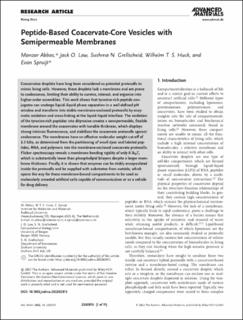| dc.contributor.author | Abbas, Manzar | |
| dc.contributor.author | Law, Jack Owen | |
| dc.contributor.author | Grellscheid, Sushma Nagaraja | |
| dc.contributor.author | Huck, Wilhelm T. S. | |
| dc.contributor.author | Spruijt, Evan | |
| dc.date.accessioned | 2023-02-27T09:17:29Z | |
| dc.date.available | 2023-02-27T09:17:29Z | |
| dc.date.created | 2022-09-08T09:59:12Z | |
| dc.date.issued | 2022 | |
| dc.identifier.issn | 0935-9648 | |
| dc.identifier.uri | https://hdl.handle.net/11250/3054083 | |
| dc.description.abstract | Coacervates droplets have long been considered as potential protocells to mimic living cells. However, these droplets lack a membrane and are prone to coalescence, limiting their ability to survive, interact, and organize into higher-order assemblies. This work shows that tyrosine-rich peptide conjugates can undergo liquid–liquid phase separation in a well-defined pH window and transform into stable membrane-enclosed protocells by enzymatic oxidation and cross-linking at the liquid–liquid interface. The oxidation of the tyrosine-rich peptides into dityrosine creates a semipermeable, flexible membrane around the coacervates with tunable thickness, which displays strong intrinsic fluorescence, and stabilizes the coacervate protocells against coalescence. The membranes have an effective molecular weight cut-off of 2.5 kDa, as determined from the partitioning of small dyes and labeled peptides, RNA, and polymers into the membrane-enclosed coacervate protocells. Flicker spectroscopy reveals a membrane bending rigidity of only 0.1kBT, which is substantially lower than phospholipid bilayers despite a larger membrane thickness. Finally, it is shown that enzymes can be stably encapsulated inside the protocells and be supplied with substrates from outside, which opens the way for these membrane-bound compartments to be used as molecularly crowded artificial cells capable of communication or as a vehicle for drug delivery. | en_US |
| dc.language.iso | eng | en_US |
| dc.publisher | Wiley | en_US |
| dc.rights | Navngivelse-Ikkekommersiell 4.0 Internasjonal | * |
| dc.rights.uri | http://creativecommons.org/licenses/by-nc/4.0/deed.no | * |
| dc.title | Peptide-Based Coacervate-Core Vesicles with Semipermeable Membranes | en_US |
| dc.type | Journal article | en_US |
| dc.type | Peer reviewed | en_US |
| dc.description.version | publishedVersion | en_US |
| dc.rights.holder | Copyright 2021 The Authors | en_US |
| dc.source.articlenumber | 2202913 | en_US |
| cristin.ispublished | true | |
| cristin.fulltext | original | |
| cristin.qualitycode | 2 | |
| dc.identifier.doi | 10.1002/adma.202202913 | |
| dc.identifier.cristin | 2049785 | |
| dc.source.journal | Advanced Materials | en_US |
| dc.identifier.citation | Advanced Materials. 2022, 34 (34), 2202913. | en_US |
| dc.source.volume | 34 | en_US |
| dc.source.issue | 34 | en_US |

